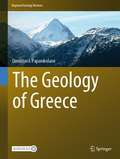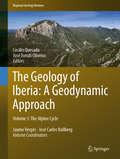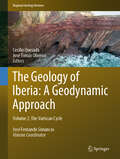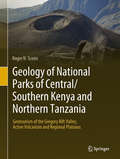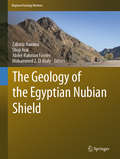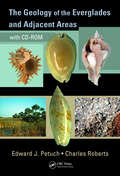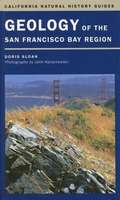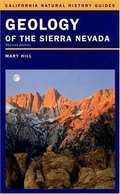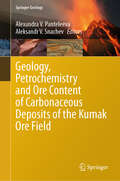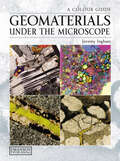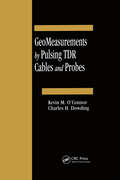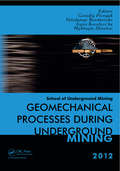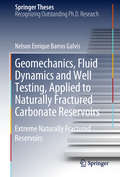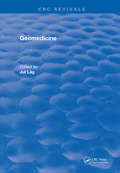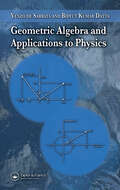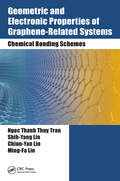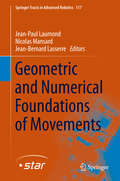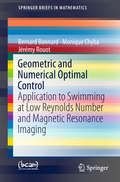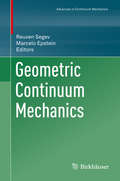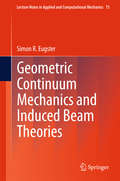- Table View
- List View
The Geology of Greece (Regional Geology Reviews)
by Dimitrios I. PapanikolaouThis book introduces the reader to the unique geology of Greece. This country is a natural geology laboratory that can help us understand the present-day active geodynamic processes in the Hellenic orogenic arc, including earthquakes, volcanoes, coastline changes and other processes of uplift and subsidence, as well as the intense erosion, transport and deposition of sediments. Additionally, Greece offers a remarkable geological museum, reflecting the complex history of the area over the last 300 million years. By studying the rocks of Greece, one can discover old oceanic basins, e.g. in the Northern Pindos and Othrys mountains, crystalline rocks of Palaeozoic age, old granitic and volcanic rocks, as well as other sedimentary rocks including fossils from the shallow neritic facies to pelagic and abyssal facies. The younger sediments demonstrate the continuously changing palaeogeography of Greece, with areas of lakes, high plateaus and gulfs that are transformed into new forms of islands, peninsulas or high mountains, etc. All the above subjects are included in the book, which describes the tectonic structure of the geological strata, together with the evolutionary stages of the palaeogeography and geodynamics within the broader Mediterranean context. A special characteristic of the book is the development of the orogenic model of the Hellenides with the application of the tectono-stratigraphic terrane concept in the Tethyan system.
The Geology of Iberia: Volume 3: The Alpine Cycle (Regional Geology Reviews)
by Cecilio Quesada José Tomás OliveiraTaking a new global approach, this unique book provides an updated review of the geology of Iberia and its continental margins from a geodynamic perspective. Owing to its location close to successive plate margins, Iberia has played a pivotal role in the geodynamic evolution of the Gondwanan, Rheic, Pangea, Tethys s.l. and Eurasian plates over the last 600 Ma of Earth's history. The geological record starts with the amalgamation of Gondwana in the Neoproterozoic succeeded by the rifting and spreading of the Rheic ocean; its demise, which led to the amalgamation of Pangea in the late Paleozoic; the rifting and spreading of several arms of the Neotethys ocean in the Mesozoic Era and their ongoing closure, which was responsible for the Alpine orogeny. The significant advances in the last 20 years have attracted international research interest in the geology of the Iberian Peninsula. This volume presents the most comprehensive, and updated description of the Alpine cycle in Iberia. This volume focuses in the different geological events during the Alpine orogeny as well as the lithological succession . This book is of interest not only for scientists of Portugal and Spain but also for geoscientists searching for analogies for oil and gas as well as tourists visiting the main mountain ridges of Iberia such as the Pyrenees.
The Geology of Iberia: Volume 2: The Variscan Cycle (Regional Geology Reviews)
by Cecilio Quesada José Tomás OliveiraTaking a new global approach, this unique book provides an updated review of the geology of Iberia and its continental margins from a geodynamic perspective. Owing to its location close to successive plate margins, Iberia has played a pivotal role in the geodynamic evolution of the Gondwanan, Rheic, Pangea, Tethys s.l. and Eurasian plates over the last 600 Ma of Earth's history. The geological record starts with the amalgamation of Gondwana in the Neoproterozoic succeeded by the rifting and spreading of the Rheic ocean; its demise, which led to the amalgamation of Pangea in the late Paleozoic; the rifting and spreading of several arms of the Neotethys ocean in the Mesozoic Era and their ongoing closure, which was responsible for the Alpine orogeny. The significant advances in the last 20 years have attracted international research interest in the geology of the Iberian Peninsula. This volume presents the most comprehensive, careful and updated description of the variscan cycle in Iberia. This volume focuses in the different geological events since the Cambrian-Early Ordovician rift until the late variscan orocline formations including magmatic and metamorphic evolution.
The Geology of Kuwait (Regional Geology Reviews)
by Abd el-aziz Khairy Abd el-aal Jasem Mohammed Al-Awadhi Ali Al-DousariThis open access book contains a set of chapters covering all aspects of geosciences related to Kuwait and adjacent regions, including Iran, Saudi Arabia and the Arab Gulf states. It covers basic information about the geology including a wide range of geoscientific disciplines such as marine geology, structural geology, hydrogeology and geophysics related to the region. This book is aimed at researchers and students, as well as professionals in the field of hazard mitigation and petroleum exploration.
Geology of National Parks of Central/Southern Kenya and Northern Tanzania: Geotourism Of The Gregory Rift Valley, Active Volcanism And Regional Plateaus
by Roger N. ScoonThis book describes the interrelationship between the spectacular geology of an area of East Africa that includes a branch of the rift valley, as well as giant freestanding ice-capped mountains and extraordinarily toxic, alkaline lakes, and some of the greatest concentrations of wildlife on Earth. It suggests that geological processes that have shaped the iconic landforms, including active volcanoes, may also be responsible for the unusually diverse speciation which characterises the region. Moreover, it is not a coincidence that important palaeoanthropological discoveries have been unearthed in the region. National parks and conservation areas have tremendous potential for geotourism and the book assists both tour guides and visitors in this regard. In addition, the book may provide a better understanding to management of the importance of geology for sustaining wildlife.
The Geology of the Egyptian Nubian Shield (Regional Geology Reviews)
by Zakaria Hamimi Shoji Arai Abdel-Rahman Fowler Mohammed Z. El-BialyThis richly illustrated book provides an overview of the Neoproterozoic Pan-African Belt of Egypt (PABE), which represents the northwestern continuation of the Arabian-Nubian Shield (ANS) and the East African Orogen (EAO). The first chapter offers an introduction to the Turin Papyrus Map and the historical background of the PABE, while the second addresses how the PABE is related to the ANS and EAO. Rock succession of the PABE is dealt with in Chapter 3, while Chapter 4 focuses on Sinai Metamorphic Core Complexes and implications on the break-up of Rodinia. Subsequent chapters discuss a broad range of topics, e.g. ophiolite-dominated suprastructural rocks; volcanosedimentary succession, Neoproterozoic volcanism and volcanic rocks in Egypt; enigmatic issues concerning granite, Dokhan and Hammamat sediments; the lithospheric mantle beneath the Northeast African continent and the mantle section of Neoproterozoic ophiolites from the PABE; sutures, megashears and petrogenetic evolution of the Neoproterozoic rocks of Egypt; and metallic and non-metallic mineral deposits in the PABE, which are covered in extensive detail. The book’s closing chapters discuss the application of remote sensing techniques and anisotropy of magnetic susceptibility (AMS) to decipher the tectonic evolution of the PABE, as well as the use of geophysical data to map structural features and hydrothermal alteration zones in the PABE.
The Geology of the Everglades and Adjacent Areas
by Edward J. Petuch Charles RobertsPainting a complete picture of the history of the Everglades, The Geology of the Everglades and Adjacent Areas brings together theperspectives of various geoscientists to provides an overview of the geology, paleontology, and paleoceanography of the Everglades region. It emphasizes the upper 300 m of the geologic framework of the area and gives insight into the local stratigraphy, geomorphology, lithology, and historical geology. Building upon the geologic nomenclature and stratigraphic sequences set down by the Florida Geological Survey, the book includes redefinitions of some previously poorly known formations, the chronological fine-tuning of other poorly known units, and the description of 7 new members.Designed to be a field guide as well as a reference, the book is illustrated with photographs of exposed geologic sections, stratotype localities, collection sites, and details of interesting fossil beds. It contains 124 full-page illustrations with 69 black and white figures, 43 black and white plates of index fossils, and 12 full color plates of simulated space shuttle images of Florida’s ancient seas and coastlines. This text is accompanied by downloadable resources that feature animated maps along with a Power Point presentation of simulated space shuttle imagery of Eocene-to-Holocene Florida. The book is arranged by geologic time, ranging from the late Eocene, Oligocene, Miocene, Pliocene, and Pleistocene to the Holocene. The authors place lithostratigraphic descriptions of the geologic formations and members into this chronological framework, along with the paleogeography of the seas and lakes within which they were deposited. They also emphasize biostratigraphy with over 1000 index fossils listed and over 400 illustrated. The book brings together information previously spread through innumerable publications, saving you the time and effort it would take to assemble and cross-reference multiple sources.
Geology of the Great Plains and Mountain West
by Cynthia Light BrownAnswering intriguing questions such as Why does the largest river system in North America meander across the middle of the continent? and How does such a system relate to the rugged Rocky Mountains?, this fun-filled book delves into the majestic Great Plains region. The chapters concisely clarify the interrelated subjects of terrain, climate, and the great movements of the earth itself while illustrating the important changes that are still occurring in the area's rivers, lakes, plains, and unpredictable weather. Brimming with fascinating facts, educational sidebars tell how earthquakes in New Madrid, Missouri caused waves to go upstream in the Mississippi River; why and how tornadoes form; and how invasive species are threatening the Great Lakes and what people are doing about it.
Geology of the San Francisco Bay Region (California Natural History Guides)
by Doris SloanThis book is for San Francisco Bay Area residents and visitors who want to explore the geologic world of this spectacular area, to learn about its shapes, colors, and rocky foundations. Doris Sloan illuminates the colorful geologic mosaic that surrounds San Francisco Bay and lucidly explains the complex and fascinating processes that have forged it over millions of years.
Geology of the Sierra Nevada (Revised Edition)
by Mary HillThe author introduces the rocks of the Sierra Nevada, which tell the mountains' tale, and explains how nature's forces, such as volcanic eruptions, earthquakes, faulting, erosion, and glaciation formed the range's world-renowned scenery and mineral wealth, including gold.
Geology, Petrochemistry and Ore Content of Carbonaceous Deposits of the Kumak Ore Field (Springer Geology)
by Alexandra V. Panteleeva Aleksandr V. SnachevThe main prospects for expanding the mineral resource base of gold are associated with the discovery of typical ore objects within the distribution of productive black shale strata in the Orenburg part of the Southern Urals. The solution of this problem is significantly associated with the discovery, evaluation and involvement in the industrial development of gold deposits lying in the black shale strata. Their practical significance, based on existing concepts, can be considered in several aspects: first of all, it is a possible source of metals, and secondly, they are a reducing geochemical barrier for the deposition of ore matter of deep fluids. The formations of the black shale formation are a favorable geochemical environment for the primary concentration of gold, platinum group elements, tungsten, molybdenum and other metals. Areas of manifestation of tectonic activity, zonal and contact metamorphism, and the dyke complex are of great importance. Moreover, carbonaceous deposits are a very informative material for the reconstruction of paleogeographic and physico-chemical conditions of their accumulation. In this regard, the ore-containing black shales of the Kumak deposit, whose rocks have a specialization in gold, seem to be a very attractive object for a comprehensive study of ore content. They may be of great practical importance for the search for new deposits in the Southern Urals and in other regions with a similar geological structure.
Geomaterials Under the Microscope: A Colour Guide
by Jeremy InghamThe first comprehensive guide to the petrography of geomaterials, making the petrographers specialist knowledge available to practitioners, educators and students worldwide interested in modern and historic construction materials.
GeoMeasurements by Pulsing TDR Cables and Probes
by Kevin M O'Connor Charles H DowdingGeoMeasurements by Pulsing TDR Cables and Probes examines Time Domain Reflectometry (TDR) research and provides information on its use as a robust, reliable, and economical production tool.Common uses for TDR technology include telecommunications and power industries, but the text examines applications such as measurement of moisture of unsaturated soils; detection of fluids for leak and pollution; measurement of water levels for hydrological purposes; measurement of water pressures beneath dams; and deformation and stability monitoring of mines, slopes, and structures.Chapters discuss:basic physics of signal generation, transmission, and attenuation along the coaxial cableprobe designs and procedures for calibration as well as the variation in probe responses to changes in water content and soil mineralogyvariations in waveform characteristics associated with cable, deformation, cable calibration, and installation techniques for metallic cables in rockseveral cases demonstrating the use of TDR cables in soil as well as weathered and soft rocka rationale for the use of compliant cable in soilthe use of metallic cable (MTDR) and optical fiber (OTDR) to monitor response of structuressensor/transducer components, connections from the sensors to the TDR pulser/sampler, and system control methodsavailable software for transmission and analysis of TDR signatures The diverse interest and terminology within the TDR community tends to obscure commonalities and the universal physical principles underlying the technology. The authors seek to crystallize the basic principles among the seemingly divergent specialties using TDR technology in geomaterials. By examining varied experiences, GeoMeasurements by Pulsing TDR Cables and Probes provides a synergistic text necessary to unify the field.
Geomechanical Processes during Underground Mining: School of Underground Mining 2012
by Genadiy Pivnyak Volodymyr Bondarenko Iryna Kovalevs'Ka Mykhaylo IlliashovThis volume deals with economic aspects of mining companies development strategies, various mineral deposits development techniques, imitational modeling of mine workings with rock massif, methane extraction technologies during coal mining, geomechanical processes during plow mining, mining transport importance for mineral extraction, massif
Geomechanics, Fluid Dynamics and Well Testing, Applied to Naturally Fractured Carbonate Reservoirs
by Nelson Enrique Barros GalvisThis thesis presents an important step towards a deeper understanding of naturally fractured carbonate reservoirs (NFCRs). It demonstrates the various kinds of discontinuities using geological evidence, mathematical kinematics model and computed tomography and uses this as a basis for proposing a new classification for NFCRs. Additionally, this study takes advantage of rock mechanics theory to illustrate how natural fractures can collapse due to fluid flow and pressure changes in the fractured media. The explanations and mathematical modeling developed in this dissertation can be used as diagnostic tools to predict fluid velocity, fluid flow, tectonic fracture collapse, pressure behavior during reservoir depleting, considering stress-sensitive and non-stress-sensitive, with nonlinear terms in the diffusivity equation applied to NFCRs. Furthermore, the book presents the description of real reservoirs with their field data as the principal goal in the mathematical description of the realistic phenomenology of NFCRs.
Geomechanics of Oil and Gas Wells (Advances in Oil and Gas Exploration & Production)
by Vladimir Karev Yuri Kovalenko Konstantin UstinovThe book presents an integrated approach to studying the geomechanical processes occurring in oil and gas-bearing formations during their development. It discusses the choice of a model that takes into account the basic properties of rocks; experiments to find model parameters; numerical modeling; and direct physical modeling of deformation and filtration processes in reservoir and host rocks. Taking into account features of rock behavior, such as anisotropy of the mechanical properties of rocks during elastoplastic deformation; dependence of permeability on the total stress tensor; the contribution of the filtration flow to the formation stress state; and the influence of tangential as well as normal stresses on the transition to inelastic deformation, it demonstrates how the presented approach allows the practical problems of increasing the productivity of wells, oil recovery, and ensuring the stability of wellbores to be solved.The book is intended for specialists, including geoengineers working in the oil and gas sector, teachers, graduate students and students, as well as all those interested in scientific and technological developments to meet the enormous demand for raw materials and energy.
Geomedicine (CRC Press Revivals)
by Jul LagThis fascinating work features such topics as the relationships between iodine deficiency and goiter, fluorine deficiency and caries, selenium deficiency and muscular degeneration, mercury surplus and specific nerve diseases, cadmium surplus and kidney failure. This one-of-a-kind volume reveals discoveries which may be of importance in future preventive medicine for man and animals. It shows that the comprehensive progress in chemical analyses has established a valuable basis for determining many environmental features and for the foundation of modern geomedicine. Those involved with geology, soil science, nutrition, biology, veterinary sciences, and prophylactic socio-medical sciences will find this resource indispensable.
Geometric Algebra and Applications to Physics
by Venzo de Sabbata Bidyut Kumar DattaBringing geometric algebra to the mainstream of physics pedagogy, Geometric Algebra and Applications to Physics not only presents geometric algebra as a discipline within mathematical physics, but the book also shows how geometric algebra can be applied to numerous fundamental problems in physics, especially in experimental situations. This
Geometric Algebra Applications Vol. III: Integral Transforms, Machine Learning, and Quantum Computing
by Eduardo Bayro-CorrochanoThe goal of Geometric Algebra Applications Vol. III: Integral Transforms, Machine Learning, and Quantum Computing is to present a unified mathematical treatment of diverse problems in the general domain like Clifford Fourier Transforms, Deep Learning and Geometric Algebra Convolutional Neural Networks, Quaternion Quantum Fourier Transform and Geometric Quantum Computing. Topics and features · Introduces nonspecialists to Clifford, or geometric algebra and by example encourages the reader to learn to compute using geometric entities and geometric formulations. · A study in depth for applications of Lie group theory, Lie algebra, projective geometry, and the algebra of incidence using the conformal geometric algebra. · Features the computing frameworks of the linear model n-dimensional affine plane and the nonlinear model of Euclidean space known as the horosphere, and addresses the relationships of these models to conformal, affine, and projective geometries. · Includes a thorough study of Integral transforms: Quaternion and Clifford Transforms, quaternion analytic signal, monogenic signals, Hilbert transform, Riesz transform, Clifford Fourier Transform, Quaternion Wavelet transforms, Quaternion Quantum Fourier Transform, 3D Radon Transform and Hough-Transform in geometric algebra. · Color image processing using the color model HSV, Quaternion Split rotors and motors, and the space-time Lorentz transform. · Geometric neural computing using Split Quaternions, Geometric Algebra neural networks, Clifford Support Vector Machine and Neuro Control. · Thorough discussion of several tasks of computer vision, graphics, neurocomputing, and robotics. machine learning, Deep Learning and CNNs, and Geometric Quantum Computing using the geometric algebra framework. · 130 exercises and hints for the development of future computer software packages for extensive calculations in geometric algebra. An entire section is dedicated to explaining how one should write the subroutines in C++, Phyton, Matlab, and Maple to carry out efficient geometric computations in the geometric algebra framework. Furthermore, it is shown how program code can be optimized for real-time computations. The book is an essential resource for applied mathematicians, physicists, computer scientists, graphics engineering, AI and Machine Learning researchers, roboticists and mechanical and electrical engineers, neurocomputing researchers, neuroscientists, and quantum computing specialists. It clarifies and demonstrates the importance of geometric computing for building autonomous systems and pushes forward advances in geometric cybernetics research.
Geometric and Electronic Properties of Graphene-Related Systems: Chemical Bonding Schemes
by Ngoc Thanh Tran Shih-Yang Lin Chiun-Yan Lin Ming-Fa LinDue to its physical, chemical, and material properties, graphene has been widely studied both theoretically and experimentally since it was first synthesized in 2004. This book explores in detail the most up-to-date research in graphene-related systems, including few-layer graphene, sliding bilayer graphene, rippled graphene, carbon nanotubes, and adatom-doped graphene, among others. It focuses on the structure-, stacking-, layer-, orbital-, spin- and adatom-dependent essential properties, in which single- and multi-orbital chemical bondings can account for diverse phenomena. <P><P>Geometric and Electronic Properties of Graphene-Related Systems: Chemical Bonding Schemes is excellent for graduate students and researchers, but understandable to undergraduates. The detailed theoretical framework developed in this book can be used in the future characterization of emergent materials.
Geometric and Numerical Foundations of Movements
by Jean-Paul Laumond Nicolas Mansard Jean-Bernard LasserreThis book aims at gathering roboticists, control theorists, neuroscientists, and mathematicians, in order to promote a multidisciplinary research on movement analysis. It follows the workshop " Geometric and Numerical Foundations of Movements " held at LAAS-CNRS in Toulouse in November 2015[1]. Its objective is to lay the foundations for a mutual understanding that is essential for synergetic development in motion research. In particular, the book promotes applications to robotics --and control in general-- of new optimization techniques based on recent results from real algebraic geometry.
Geometric and Numerical Optimal Control: Application to Swimming at Low Reynolds Number and Magnetic Resonance Imaging (SpringerBriefs in Mathematics)
by Bernard Bonnard Monique Chyba Jérémy RouotThis book introduces readers to techniques of geometric optimal control as well as the exposure and applicability of adapted numerical schemes. It is based on two real-world applications, which have been the subject of two current academic research programs and motivated by industrial use – the design of micro-swimmers and the contrast problem in medical resonance imaging. The recently developed numerical software has been applied to the cases studies presented here. The book is intended for use at the graduate and Ph.D. level to introduce students from applied mathematics and control engineering to geometric and computational techniques in optimal control.
Geometric and Topological Methods for Quantum Field Theory
by Alexander Cardona Iván Contreras Andrés F. Reyes-LegaThis volume offers an introduction, in the form of four extensive lectures, to some recent developments in several active topics at the interface between geometry, topology and quantum field theory. The first lecture is by Christine Lescop on knot invariants and configuration spaces, in which a universal finite-type invariant for knots is constructed as a series of integrals over configuration spaces. This is followed by the contribution of Raimar Wulkenhaar on Euclidean quantum field theory from a statistical point of view. The author also discusses possible renormalization techniques on noncommutative spaces. The third lecture is by Anamaria Font and Stefan Theisen on string compactification with unbroken supersymmetry. The authors show that this requirement leads to internal spaces of special holonomy and describe Calabi-Yau manifolds in detail. The last lecture, by Thierry Fack, is devoted to a K-theory proof of the Atiyah-Singer index theorem and discusses some applications of K-theory to noncommutative geometry. These lectures notes, which are aimed in particular at graduate students in physics and mathematics, start with introductory material before presenting more advanced results. Each chapter is self-contained and can be read independently.
Geometric Continuum Mechanics (Advances in Mechanics and Mathematics #42)
by Marcelo Epstein Reuven SegevThis contributed volume explores the applications of various topics in modern differential geometry to the foundations of continuum mechanics. In particular, the contributors use notions from areas such as global analysis, algebraic topology, and geometric measure theory. Chapter authors are experts in their respective areas, and provide important insights from the most recent research. Organized into two parts, the book first covers kinematics, forces, and stress theory, and then addresses defects, uniformity, and homogeneity. Specific topics covered include:Global stress and hyper-stress theoriesApplications of de Rham currents to singular dislocationsManifolds of mappings for continuum mechanicsKinematics of defects in solid crystalsGeometric Continuum Mechanics will appeal to graduate students and researchers in the fields of mechanics, physics, and engineering who seek a more rigorous mathematical understanding of the area. Mathematicians interested in applications of analysis and geometry will also find the topics covered here of interest.
Geometric Continuum Mechanics and Induced Beam Theories
by Simon R. EugsterThis research monograph discusses novel approaches to geometric continuum mechanics and introduces beams as constraint continuous bodies. In the coordinate free and metric independent geometric formulation of continuum mechanics as well as for beam theories, the principle of virtual work serves as the fundamental principle of mechanics. Based on the perception of analytical mechanics that forces of a mechanical system are defined as dual quantities to the kinematical description, the virtual work approach is a systematic way to treat arbitrary mechanical systems. Whereas this methodology is very convenient to formulate induced beam theories, it is essential in geometric continuum mechanics when the assumptions on the physical space are relaxed and the space is modeled as a smooth manifold. The book addresses researcher and graduate students in engineering and mathematics interested in recent developments of a geometric formulation of continuum mechanics and a hierarchical development of induced beam theories.
